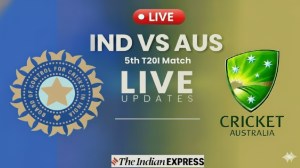Stay updated with the latest - Click here to follow us on Instagram
Snake Bite Doctor
He has a way with snakes and is a walking encyclopaedia on snake venom and snakebites.
He has a way with snakes and is a walking encyclopaedia on snake venom and snakebites. During a visit to Yavatmal last year,Bharat Joshi,better known as Sarpamitra (a friend of snakes),saw a snake slither close to a blind farmer. Joshi,who has been conducting workshops for the past 25 years to train people in handling snakes and snakebites,suddenly had an urge to pass on his knowledge to the visually impaired.
The result was Sarpasparsh (the touch of a snake) the first-ever book in Braille on snakes and snakebites.
I had a passion for snakes and a desire to help the blind. Through Sarpasparsh I channelled both into one, says Joshi,
Recalling his feeling when he saw the snake crawling near the blind farmer,he says,I told myself I have taught many about dealing with snakes but the visually challenged need this knowledge more.
Shortly after that,he was conducting a camp for students of the Kamlabai Mehta School for the Blind in Dadar when its principal Kunda Ajgaonkar suggested that he write a book.
In November,he joined the National Association for the Blind at Worli to learn Braille and mastered it within a month. He immediately started working on the book.
Hemant Patil,a visually challenged professor at NAB taught him Braille and a visually challenged woman read the proofs of the book. Over three hundred copies of Sarpasparsh have been printed and nearly a hundred blind schools across the country have been sent a copy each.
The book is slated for official release on the 201st birth anniversary of Louis Braille,who invented the six-point Braille script,on January 4. The day is celebrated as International Braille Day. Braille is one of the most difficult scripts as there are combinations of only six points unlike languages like English that have 24 alphabets, says Joshi.
I have tried to keep the book simple. Importance of snakes in the Indian culture,ways to avoid snakes and snakebite and identify snakebite symptoms,besides information on poisonous snakes in India,what to do when a snake enters the house,first aid and treatment to be given in hospital after a snakebite,superstitions and safe rehabilitation of snakes have been covered, says Joshi,who passed out of the Bhosala Military School in Nashik in 1971 before he joined the state Home Guard in 1974.
Braille readers are already praising the book. 14-year-old Chaitali Zagde,a visually challenged student of Kamlabai Mehta School,said,It is easy to understand. I have already read half; it is informative and interesting.
Looking at two cobras lying coiled in a jar on his table,56-year-old Joshi recalls how he was introduced to the world of snakes when he was posted as Home Guard for 54 days outside the snake farming center at the Haffkines Institute in Parel in 1985. There were four poisonous snakes in four glass cases,a krait,cobra,Russell viper and a saw-scaled viper. We had to feed them white mice once every two days. One day when I was feeding the cobra,it sprang out of the glass box. I fled and locked the room. A professor from Haffkines who had a Ph.D and was an authority on snake venoms calmly went inside,lifted the cobra and placed it inside the case. It was then that my urge to know about snakes was born, says Joshi. The same professor taught him about snake venom. Joshi also started reading books on snakes from the Haffkines library.
Joshi,who has rescued over 350 snakes across the city in the past 25 years,had written two books earlier,Bharatatil Sarp (Snakes In India) and Adhunik Nag-panchami that try to break myths and superstitions about snakes in Indian.
Joshi is the recipient of the Chief Ministers Award for meritorious work in social and educational field. He also got the Best Workmens Welfare Award from former governor Omprakash Mehra.
After retirement in 1996,Joshi continued to conduct workshops and camps. His students age ranges from 3 years to 21 years. Every year,he conducts around ten camps of ten days each in Maharashtra in places like Mahabaleshwar,Matheran,Pune,Ahmednagar and Sangli,besides Kamlabai Mehta School and another school for the blind in Pune.







